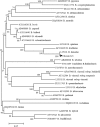Scalp eschar and neck lymphadenopathy after tick bite (SENLAT) caused by Bartonella henselae in Korea: a case report
- PMID: 32164559
- PMCID: PMC7066777
- DOI: 10.1186/s12879-020-4940-0
Scalp eschar and neck lymphadenopathy after tick bite (SENLAT) caused by Bartonella henselae in Korea: a case report
Abstract
Background: Tick-borne lymphadenopathy (TIBOLA) is an infectious disease, mainly caused by species from the spotted fever group rickettsiae and is characterized by enlarged lymph nodes following a tick bite. Among cases of TIBOLA, a case of scalp eschar and neck lymphadenopathy after tick bite (SENLAT) is diagnosed when an eschar is present on the scalp, accompanied by peripheral lymphadenopathy (LAP). Only a few cases of SENLAT caused by Bartonella henselae have been reported.
Case presentation: A 58-year-old male sought medical advice while suffering from high fever and diarrhea. Three weeks before the visit, he had been hunting a water deer, and upon bringing the deer home discovered a tick on his scalp area. Symptoms occurred one week after hunting, and a lump was palpated on the right neck area 6 days after the onset of symptoms. Physical examination upon presentation confirmed an eschar-like lesion on the right scalp area, and cervical palpation revealed that the lymph nodes on the right side were non-painful and enlarged at 2.5 × 1.5 cm. Fine needle aspiration of the enlarged lymph nodes was performed, and results of nested PCR for the Bartonella internal transcribed spacer (ITS) confirmed B. henselae as the causative agent.
Conclusion: With an isolated case of SENLAT and a confirmation of B. henselae in Korea, it is pertinent to raise awareness to physicians in other Asian countries that B. henselae could be a causative agent for SENLAT.
Keywords: Bartonella henselae; Lymph nodes; Spotted fever group Rickettsiosis; Tick-borne diseases.
Conflict of interest statement
The authors declare that they have no competing interests.
Figures


Similar articles
-
Scalp eschar and neck lymphadenopathy after tick bite in Argentina.Infez Med. 2019 Jun 1;27(2):183-186. Infez Med. 2019. PMID: 31205043
-
[Update on SENLAT syndrome: scalp eschar and neck lymph adenopathy after a tick bite].Ann Dermatol Venereol. 2013 Oct;140(10):598-609. doi: 10.1016/j.annder.2013.07.014. Epub 2013 Aug 23. Ann Dermatol Venereol. 2013. PMID: 24090889 Review. French.
-
Scalp eschar and neck lymphadenopathy by Rickettsia slovaca after Dermacentor marginatus tick bite case report: multidisciplinary approach to a tick-borne disease.BMC Infect Dis. 2021 Jan 22;21(1):103. doi: 10.1186/s12879-021-05807-3. BMC Infect Dis. 2021. PMID: 33482743 Free PMC article.
-
Scalp eschar and neck lymphadenopathy caused by Bartonella henselae after Tick Bite.Clin Infect Dis. 2010 Feb 15;50(4):549-51. doi: 10.1086/650172. Clin Infect Dis. 2010. PMID: 20070235
-
Cellulitis of the face associated with SENLAT caused by Rickettsia slovaca detected by qPCR on scalp eschar swab sample: An unusual case report and review of literature.Ticks Tick Borne Dis. 2019 Aug;10(5):1142-1145. doi: 10.1016/j.ttbdis.2019.06.010. Epub 2019 Jun 12. Ticks Tick Borne Dis. 2019. PMID: 31213411 Review.
Cited by
-
Epidemiological, Clinical, and Microbiological Characteristics in a Large Series of Patients Affected by Dermacentor-Borne-Necrosis-Erythema-Lymphadenopathy from a Unique Centre from Spain.Pathogens. 2022 Apr 30;11(5):528. doi: 10.3390/pathogens11050528. Pathogens. 2022. PMID: 35631049 Free PMC article.
-
Vector-Borne Zoonotic Lymphadenitis-The Causative Agents, Epidemiology, Diagnostic Approach, and Therapeutic Possibilities-An Overview.Life (Basel). 2024 Sep 19;14(9):1183. doi: 10.3390/life14091183. Life (Basel). 2024. PMID: 39337966 Free PMC article. Review.
-
Molecular Detection of Tick-Borne Bacterial Pathogens in Patients With Undifferentiated Febrile Illness in India Using a Flow Chip Assay.Cureus. 2024 Dec 16;16(12):e75781. doi: 10.7759/cureus.75781. eCollection 2024 Dec. Cureus. 2024. PMID: 39816306 Free PMC article.
References
Publication types
MeSH terms
Grants and funding
LinkOut - more resources
Full Text Sources
Medical
Research Materials

